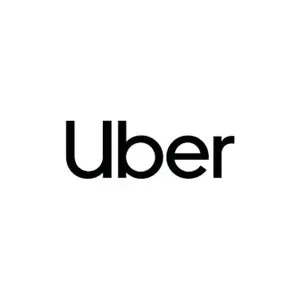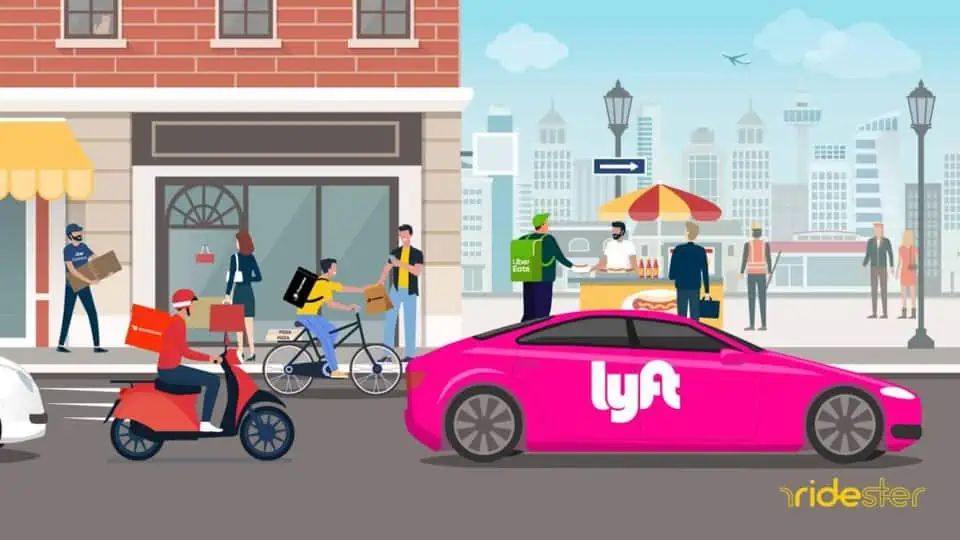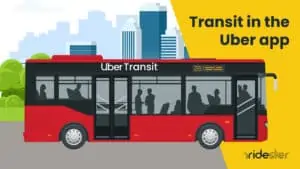The Best Uber Alternatives (Overview)
With over a hundred million people using Uber daily, it’s easy to see yourself getting stuck in the rush hour without a ride. That said, here’s a list of ridesharing companies and apps you can use other than Uber:
- LYFT: Best Overall
- VIA: Best For Price Rate
- BOLT: Best For Customization
- ARRO: Best For Stable Fare Rate
- GETT: Best For Flexibility
- CURB: Best For Planned Quick Trips
- GRAB: Best For Most Services
- WINGZ: Best For Airport Travels
- OLA CABS: Best For Offline Utility
Editor’s Choice: Our Top Picks Overall
There are plenty of companies offering similar services as Uber. But only a handful perform as well as the multibillion-dollar transportation company.
What is the Best Uber Alternative?
Lyft stands out as the best Uber alternative with its receipt transparency, superior user experience, and competitive pricing.
Focusing on passenger comfort and safety, Lyft provides plenty of practical services during commutes. That, coupled with a user-friendly interface and convenient payment options, makes it the best alternative to Uber.
Who is Uber’s Biggest Competitor?
Lyft also takes the spot as Uber’s biggest competitor in the taxi business, offering a range of services arguably on par with Uber.
The company operates in more than 600 cities in the U.S. and Canada. Being in the business for a decade, Lyft has garnered millions of active users in every major city on the continent.
An Overview of Uber
Founded in San Francisco in 2009, Uber became the most used transportation service ever. But what makes Uber stand out from its competitors? And why should you consider other apps instead?
Where Does Uber Excel?
Uber’s primary edge over other ride-hailing apps is its wide availability. The app operates globally, reaching 70 countries, 10,000 cities, and a large fleet of Uber drivers. But that’s not all.
Aside from its expansive operation, Uber boasts a wide range of services, affordable payment options, and an excellent reward system. Uber’s ride types are diverse, catering to all sorts of riders. The app also conveniently connects users to merchants and offers freight transport and food delivery.
Where Does Uber Fall Short?
Throughout the years, one common criticism against Uber is its lack of transparency in its pricing. Its receipts don’t show the route or duration of a trip, making it difficult to estimate the cost, particularly in cases of surge pricing.
If you live in a densely populated city, Uber will experience more frequent price markups than other apps because of its popularity. In these circumstances, it’s best to consider other ride-hailing apps to avoid the high cost of using the service.
The Best Uber Alternatives In 2023
Here are nine Uber-like apps you should explore for your 2023 trips:
1. Lyft

- Good: Lyft provides premium service comparable to Uber, with different categories or levels of services depending on what you need.
- Bad: Lyft fare is generally more expensive, with an average ride cost of around $27 compared to $20 for Uber.
- When to choose this Lyft alternative: In times of high demand.
Lyft is an American ride-share company founded by Logan Green and John Zimmer in 2012. How Lyft works is similar to Uber, which utilizes dedicated software to request and pay for rides. Since its launch, it has become one of the most used travel apps, second only to Uber.
Why is Lyft a Great Option?
What makes Lyft an excellent option is it implements a transparent pricing policy, allowing users to check the distance and time before confirming a ride.
Most notably, Lyft shares its drivers’ details through the app, including their names, photos, ratings, and vehicles, which helps put riders at ease. All its drivers have gone through thorough background checks.
Drawbacks to Lyft
You’re likely aware of the constant Uber vs. Lyft debate between riders. Many would argue for Lyft’s superiority because of its perceived honesty.
However, one obvious drawback of Lyft compared to Uber is its higher pricing. Lyft’s reward system for frequent riders is also limited, with fewer travel rewards than its competitors.
2. Via
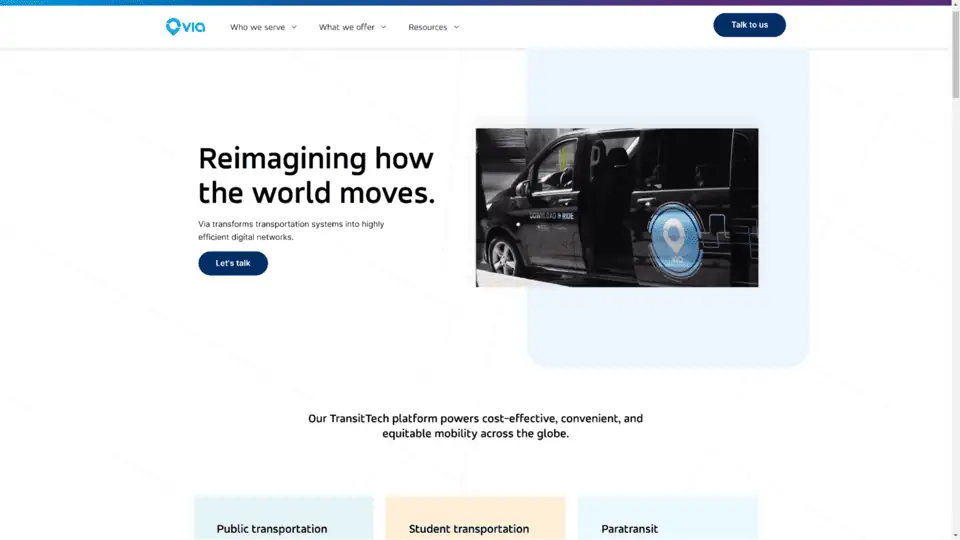
- Good: Focusing on carpooling, Via is one of the cheapest alternatives to Uber, with a flat rate payment option.
- Bad: You need to ride with several people.
- When to choose this Via alternative: When you want to save transportation money.
Via is a popular transport app with on-demand services. Founded by Daniel Ramot and Oren Shoval in 2012, the company now operates in over 35 countries worldwide. Via’s edge is its cheap pricing and eco-friendly approach.
Why is Via a Great Option?
Via is an excellent option if you don’t mind riding in groups for a cheaper fare. With Via rideshare, you can contribute to the environment by reducing carbon emissions compared to using separate vehicles.
The app’s real-time tracking is a practical tool for busy riders. With Via, you only need to choose a pick-up and drop-off location, and the app will automatically assign the car with the appropriate seating and destination.
Drawbacks to Via
Aside from the disadvantage of riding with strangers, Via uses static routes for its transport services. A static course means the driver can only drop you at a station nearest your destination, so you’d need to walk the rest.
3. Bolt
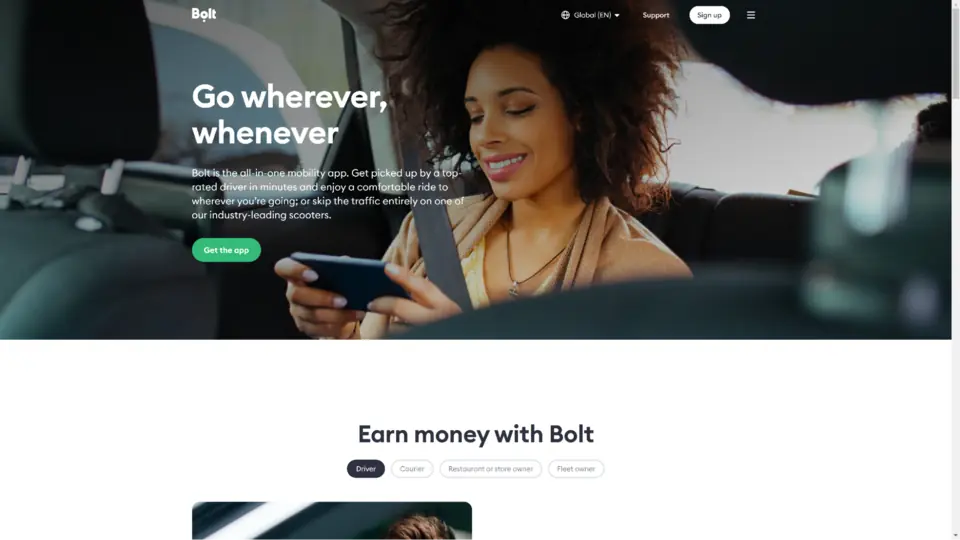
- Good: Bolt (formerly Taxify) offers a flexible ride option for riders, allowing them to customize their routes.
- Bad: The service doesn’t operate in every U.S. city.
- When to choose this Bolt alternative: When you’re a frequent rider.
Bolt is a multinational Estonian transport service founded by Markus Villig in 2013. Since its conception, the company now operates in over 500 cities in America, Europe, Asia, and Africa. In addition to its taxi app, Bolt also provides rental and delivery services.
Why is Bolt a Great Option?
Its insightful and user-friendly app makes Bolt a worthy competitor to Uber. If you’re a frequent rider, you can customize and save your routes for faster booking, even appoint specific pick-up locations on the map!
You can set up stops during your ride, which is a convenient addition if you have multiple appointments. Riders can also share their live trip using Bolt’s real-time tracking feature, making get-togethers with friends and family easier.
Drawbacks to Bolt
Bolt is relatively new compared to Uber and Lyft. So, despite its global reach, Bolt primarily operates in large urban areas.
4. Arro
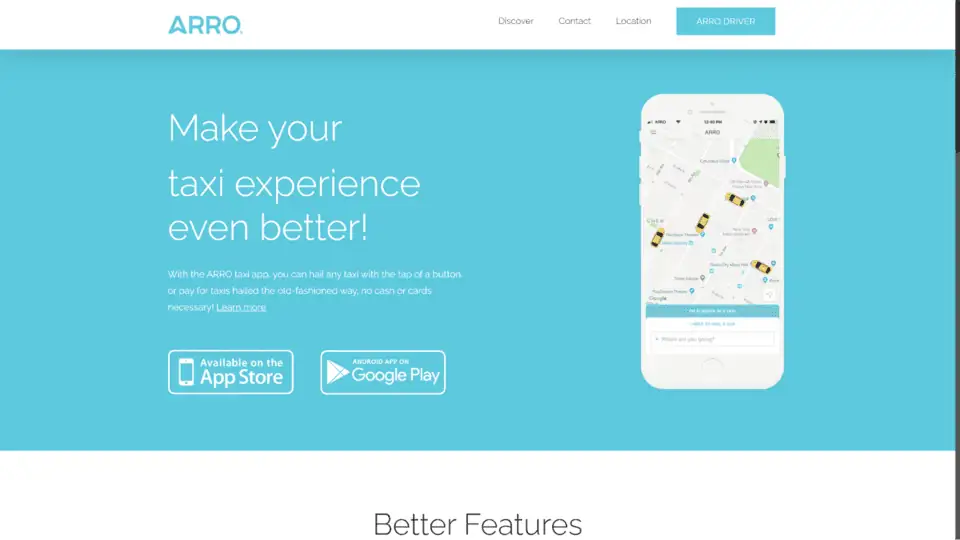
- Good: As Arro uses licensed cabs, its fare rates are more stable than other ride-share apps.
- Bad: Only available in several U.S. cities.
- When to choose this Arro alternative: If traveling in any major U.S. city.
Arro is a taxi booking app development that provides a platform for hailing and paying for taxi rides. The app works like any other ride service, connecting riders to the nearest ride with a tap of a button. Its database boasts over 20,000 taxis for 24/7 on-demand mobility.
Why is Arro a Great Option?
Arro works a lot like Uber but with a more stable fare rate. As it relies on taxi drivers in the area, your travel cost won’t surge regardless of the weather or occasion.
Arro’s drivers possess a license and are well-trained, ensuring top-notch safety for all its riders. The app also provides 24/7 customer support.
Drawbacks to Arro
The only drawback to Arro is its limited reach. It’s not as extensive as Uber and only operates in cities with large populations: New York, Chicago, San Francisco, Boston, London, Miami, and Houston.
5. Gett
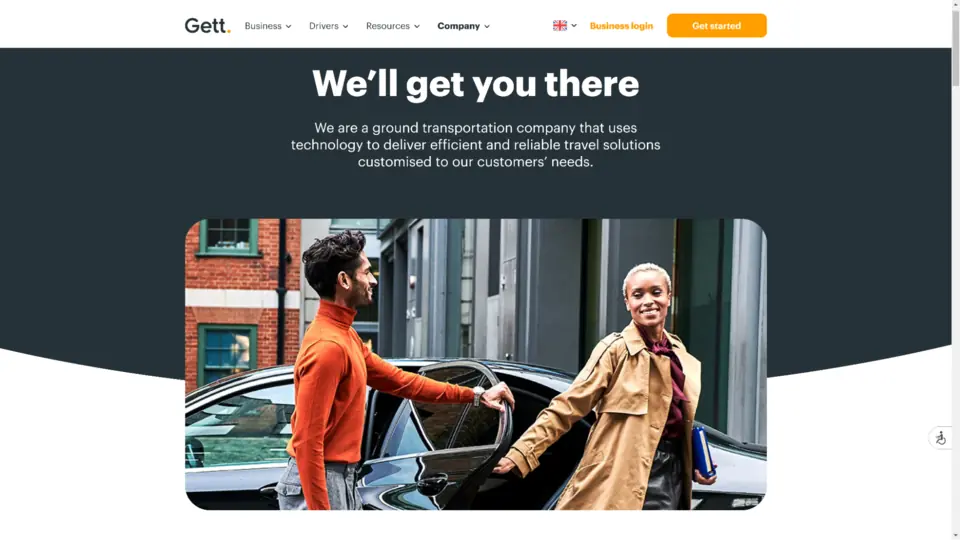
- Good: Gett is amazingly flexible, allowing riders to pre-book a vehicle at a specified date weeks before they travel.
- Bad: Canceling rides can lead to unexpected charges.
- When to choose this Gett alternative: While traveling abroad.
Gett, formerly known as GetTaxi, is an Israel-based ridesharing app. Its service covers over 100 cities worldwide—mainly in the U.K., U.S., and Israel. Dave Waiser founded Gett in 2010 and has grown into a considerable Uber competitor flaunting over one million registered drivers.
Why is Gett a Great Option?
While the pre-booking feature is a definite plus for Gett, it’s also favored for its cheap pricing, even dropping its fare rate in New York City by 25%. What’s more, Gett doesn’t charge additional charges despite the busy hours!
The app supports cashless payments, allowing riders to choose a preferred payment method. Setting up frequent trips is more effortless, too, with Gett’s AI optimization tool.
Drawbacks to Gett
One common issue raised against Gett is its unreliable cancellation policy. The low number of drivers also means you could wait longer than when using other prevalent ride-share services.
6. Curb

- Good: One of the top-rated taxi apps in the U.S., with professional and insured drivers.
- Bad: Curb has fewer drivers at its disposal.
- When to choose this Curb alternative: For planning quick daily trips.
While certainly not the largest, Curb stands out in the competitive rideshare service industry. The mobility company was founded in 2007 by the entrepreneur Amos Tamam. Curb is a long-time competitor to Uber, operating in more than 60 U.S. cities.
Why is Curb a Great Option?
Curb’s convenient quick-booking function, professional drivers, and reasonable pricing are the app’s most sought-after benefits. They offer two types of cab services: Ride Now and Ride Later.
Ride Later allows you to set a time and place for your pickup for a cheap $2 additional fee. The drivers are professional with adequate training on the road. Most importantly, Curb never charges you for surging prices!
Drawbacks to Curb
The one disadvantage to using Curb is its strict cancellation regulation. Most apps provide one to two minutes from the initial request before charges apply, but Curb only allocates 30 seconds.
7. Grab
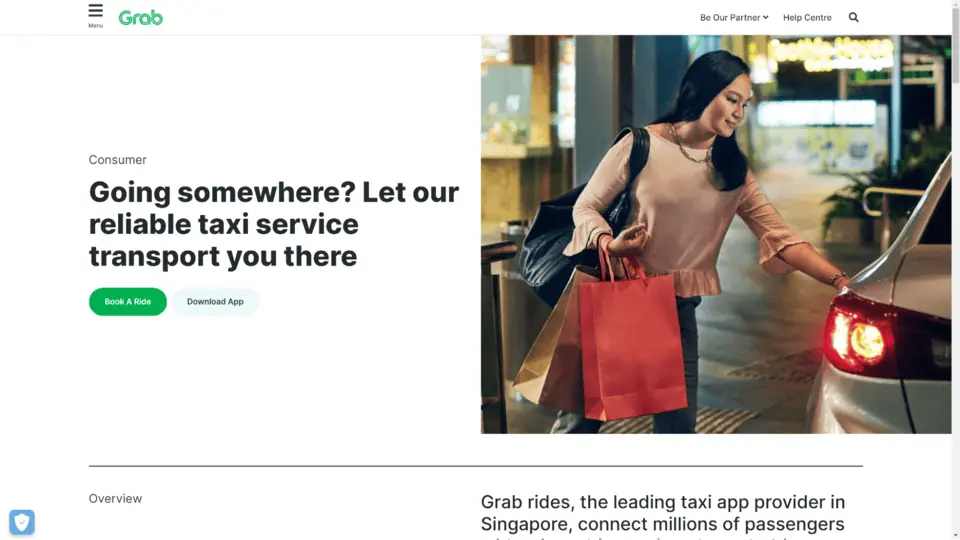
- Good: Boasts plenty of transport options, delivery services, and practical tools for all riders.
- Bad: Primarily available in Asia.
- When to choose this Grab alternative: If you’re moving to the U.S. from Asia.
Grab is an Asian brand of taxi app developed by Anthony Tan and Tan Hooi Ling in Malaysia in 2012. It’s one of the most successful startups in the Southeast Asian region, gathering 180 million users. The company recently expanded its reach to the U.S. through Lyft and offers services in over 200 U.S. cities.
Why is Grab a Great Option?
Grab’s sheer amount of functionalities in one app is its primary selling point. On top of transport, Grab handles food delivery services, hotel bookings, ticket reservations, online payments, and other money services.
Within the app is a convenient search feature to find amenities and services. It features a top-up wallet system you can use for cashless payments as well.
Drawbacks to Grab
Of course, as a company based in Asia, Grab’s services are concentrated in the region. You can only use Grab to book rides or hotels in the U.S. if you’re moving in from Southeast Asia.
8. Wingz
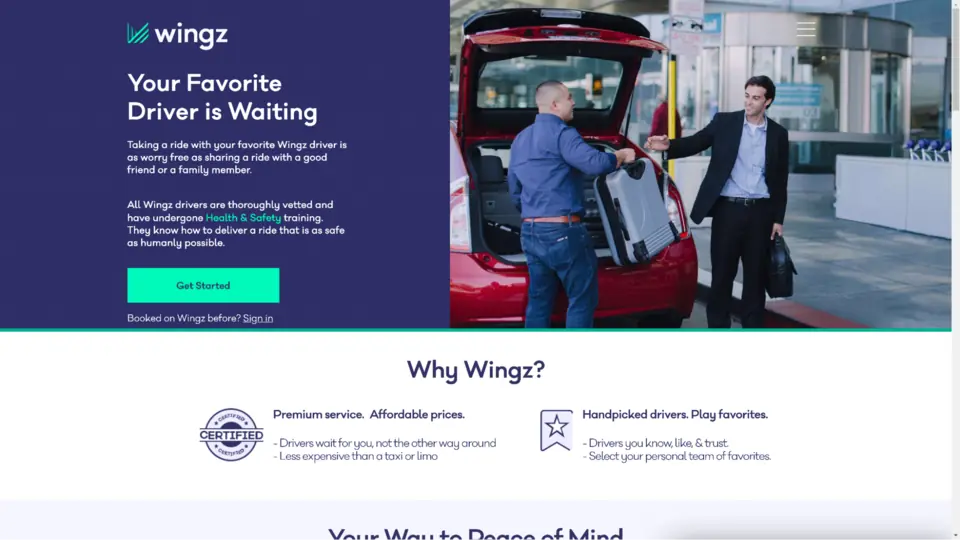
- Good: A convenient means of traveling to and fro airports in the U.S. with a reasonable price rate.
- Bad: Wingz’s operation range only covers select cities and airports.
- When to choose this Wingz alternative: If traveling from home to an airport or vice versa.
Wingz is a rideshare company based in San Francisco, offering specialized transport services. While its primary service is airport shuttle, Wingz also caters to around-town appointments. The app runs in 16 metro areas and 22 airport locations.
Why is Wingz a Great Option?
Wingz’s pricing is flat, with a fixed rate with no hidden charges. Its booking policy is incredibly flexible, too, permitting reservations months in advance.
You can use Wingz apart from the airport shuttle as well. Its drivers cater to personal appointments, such as weddings, concerts, sporting events, or even a typical night out.
Drawbacks to Wingz
Wingz isn’t available in every city and airport in the U.S. On top of that, it’s generally more expensive compared to other ride-hailing apps, including Uber.
9. Ola Cabs
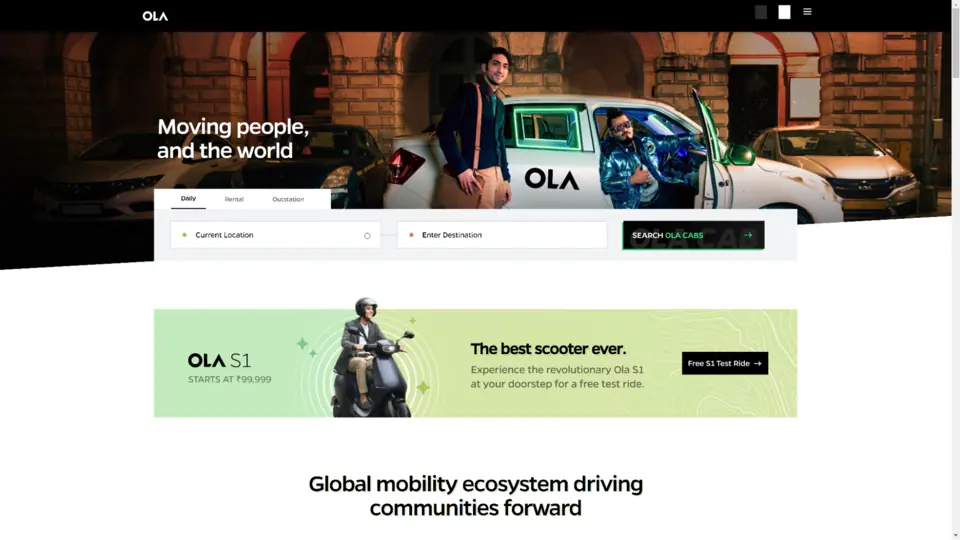
- Good: The app has an online functionality, which means you can still use its services regardless of your internet connection’s quality.
- Bad: Ola users can experience longer waiting times and higher fares during high-demand occasions.
- When to choose this Ola Cab alternative: Ola Cabs is ideal in urban areas with weak or no internet connection.
Ola Cabs is Uber’s number-one competitor in India. Favored for its feature-rich app, Ola Cabs now runs in over 250 cities in Australia, the U.K., New Zealand, and India.
Bhavish Aggarwal and Ankit Bhati are the two Indian founders behind Ola Cabs. And since its founding in 2010, the company now gets an estimated 1.5 million daily bookings!
Why is Ola Cabs a Great Option?
Ola Cabs’ appeal is in its full-featured software. Despite its lightweight size (52 MB), the Ola app comes with plenty of practical functions targeted to boost user experience.
For one, the offline functionality makes it highly convenient for constantly traveling individuals. There’s also the OTP authentication technology, which ensures optimal driver-passenger matching.
But the most noteworthy quality of Ola Cab is its multiple safety features. The app allows real-time location tracking and has an SOS button that communicates with a dedicated safety response team with a single click!
Drawbacks to Ola Cabs
While commendable, riders raise concerns about Ola Cab’s drivers and pricing. In recent years, there have been reports of Ola Cab drivers turning down riders because of their destinations.
Users can experience price markups based on time and demand rates. For instance, Ola Cab can charge extra during nighttime to encourage its drivers to take a booking.
Notable Mentions: Even More Options To Check Out
With more than 300 million people using ride-hailing apps, many names providing innovative taxi services have appeared in recent years. Here are a few of them:
1. Tesluxe For Premium Rides
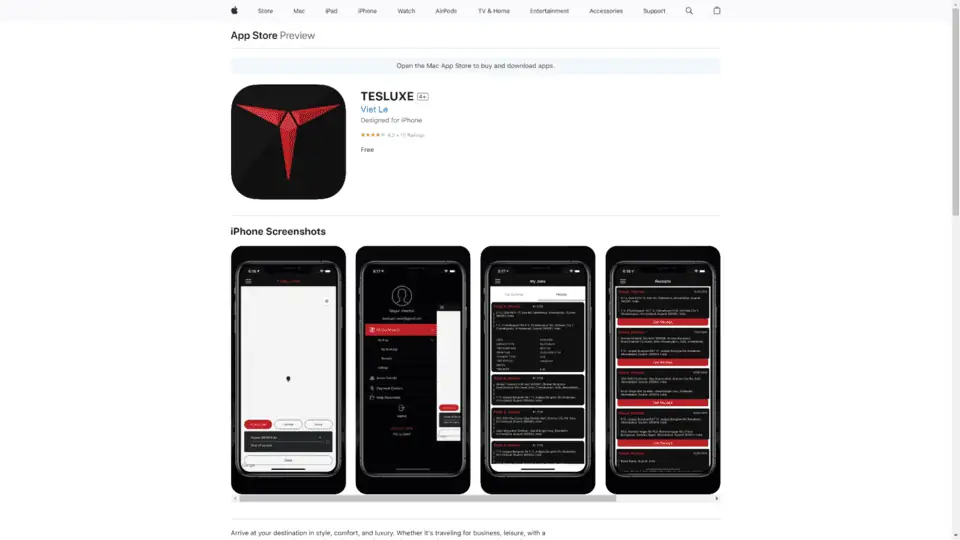
Tesluxe is a modern ride-share startup with a niche that targets premium customers. Unlike your typical ride-hailing app, the firm capitalizes on offering luxury taxi services for unique purposes.
Instead of regular vehicles, Tesluxe uses Tesla cars for transport, a brand known for its stylish and luxurious models. Because of its perks, Tesluxe has been gaining traction and attention among wealthy clients in the U.S.
2. InDriver For Negotiable Fares

InDrive is another excellent ride-hailing platform offering a unique take. In this app, the riders decide their fare and let drivers accept or negotiate until both parties arrive at an acceptable deal.
This unique business model focused on empowering customers made the app one of the strongest potential competitors to Uber. The only downside to it is the time it takes to find agreeable drivers.
3. Didi Chuxing For Diverse Rides

Didi Chuxing, as you likely guessed, is a Chinese mobility brand that’s been taking the world by storm. The company began as a basic taxi app but later expanded into vehicle, bus, and bicycle rental services.
The app comes packed with benefits, such as cheaper shared rides and features to ensure rider security. But as a newcomer in the U.S. taxi market, Didi Chuxing faces stiff competition against giant companies such as Uber and Lyft.
Frequently Asked Questions
Below are some commonly asked questions about apps like Uber that could answer some of your queries.
Is there a better ride-hailing app than Uber?
While Uber dominated the ride-hailing market for several years, plenty of apps come toe to toe with the brand. Some examples of these Uber alternatives are Lyft, Bolt, Via, and Grab.
Uber’s dominance can fluctuate based on the country, too. Ola Cabs takes the spot as the number one taxi app in India, while Didi Chuxing reigns supreme in China.
What is cheaper than Lyft?
Uber is generally cheaper than Lyft. But some factors can increase its overall rates, including rush hours, busy holidays, and city population.
Wrapping Up
For a frequent rider, relying on one ride-hailing app can spell all kinds of trouble, especially on a busy occasion. Higher costs, longer waiting times, and problematic drivers can affect the quality of your travels.
That said, now you know the nine best alternatives to the Uber app. Keep them in your travel notes, and you’ll never miss opportunities again!


